Last time we have discussed Electric Vacuum Pumps(EVPs in short). As we can see, there are many advantages of EVPs. EVPs also have many disadvantages, including noise. In the plateau area, due to the low air pressure, the EVP cannot provide the same high degree of vacuum as in the plain area, and the assistance of the vacuum booster is poor, and the pedal force will become larger. There are two most fatal shortcomings. One is the lifespan. Some cheap EVPs have a lifespan of less than 1,000 hours. The other is energy waste. We all know that when an electric vehicle is coasting or braking, the friction force can drive the motor to rotate to generate current. These currents can charge the battery and store this energy. This is braking energy recovery. Don't underestimate this energy. In the NEDC cycle of a compact car, if the braking energy can be fully recovered, it can save about 17%. In typical urban conditions, the ratio of the energy consumed by the vehicle braking to the total driving energy can reach 50%. It can be seen that if the braking energy recovery rate can be improved, the cruising range can be greatly extended and the vehicle economy can be improved. The EVP is connected in parallel with the braking system, which means that the regenerative braking force of the motor is directly superimposed on the original friction braking force, and the original friction braking force is not adjusted. The energy recovery rate is low, only about 5% of the Bosch iBooster mentioned later. In addition, the braking comfort is poor, and the coupling and switching of motor regenerative braking and friction braking will produce shocks.
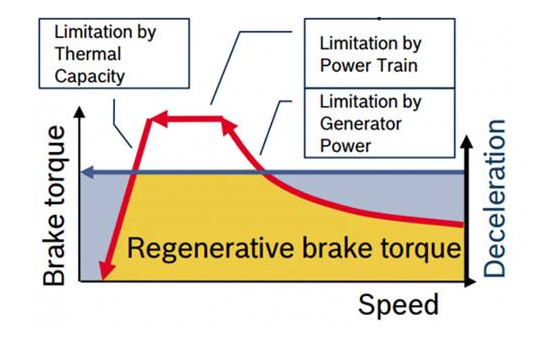
The above picture shows the SCB schematic
Even so, EVP is still widely used, because the sales of electric vehicles are low, and the domestic chassis design ability is also very poor. Most of them are copied chassis. It is almost impossible to design a chassis for electric vehicles.
If EVP is not used, EHB (Electronic Hydraulic Brake Booster) is required. EHB can be divided into two types, one is with a high-pressure accumulator, usually called the wet type. The other is that the motor directly pushes the piston of the master cylinder, usually called the dry type. Hybrid new energy vehicles are basically the former, and the typical representative of the latter is the Bosch iBooster.

Let's first look at the EHB with a high-voltage accumulator, which is actually an enhanced version of the ESP. ESP can also be regarded as a kind of EHB, ESP can actively brake.

The left picture is the schematic diagram of a wheel of ESP:
a--control valve N225
b--dynamic control high-pressure valve N227
c--oil inlet valve
d--oil outlet valve
e--brake cylinder
f--return pump
g--active servo
h--low-pressure accumulator
In the boosting stage, the motor and the accumulator build up a pre-pressure so that the return pump sucks the brake fluid. N225 is closed, N227 is opened, and the oil inlet valve remains open until the wheel is braked to the required braking strength.

The composition of EHB is basically the same as that of ESP, except that the low-pressure accumulator is replaced by a high-pressure accumulator. The high-pressure accumulator can build pressure once and use it multiple times, while the low-pressure accumulator of ESP can build pressure once and can only be used once. Every time it is used, the most core component of the ESP and the most precise component of the plunger pump have to withstand high temperature and high pressure, and continuous and frequent use will reduce its life. Then there is the limited pressure of the low-pressure accumulator. Generally, the maximum braking force is about 0.5g. The standard braking force is above 0.8g, and 0.5g is far from enough. At the beginning of the design, the ESP-controlled braking system was only used in a few emergency situations, no more than 10 times a year. Therefore, ESP cannot be used as a conventional braking system, and can only be used occasionally in auxiliary or emergency situations.

The picture above shows the high-pressure accumulator of Toyota EBC, which is somewhat similar to a gas spring. The manufacturing process of high-pressure accumulators is a difficult point. Bosch initially used energy storage balls. The practice has proved that nitrogen-based high-pressure accumulators are the most suitable.
Toyota was the first to apply the EHB system to a mass-produced car, which was the first-generation Prius (parameters | picture) launched at the end of 1997, and Toyota named it EBC. In terms of braking energy recovery, EHB is greatly improved compared with the traditional EVP, because it is decoupled from the pedal and can be a series system. The motor can be used for energy recovery first, and braking is added in the final stage.
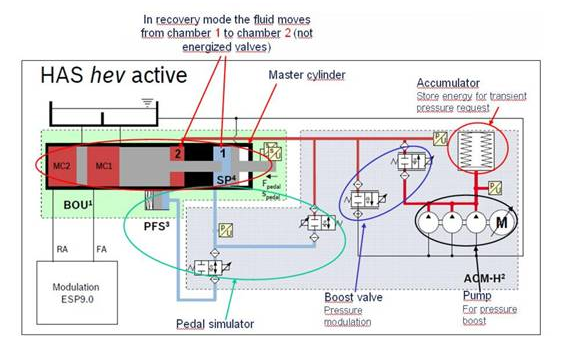
At the end of 2000, Bosch also produced its own EHB, which was used on the Mercedes-Benz SL500. Mercedes-Benz named it SBC. Mercedes-Benz's EHB system was originally used in fuel vehicles, just as an auxiliary system. The system was too complicated and had too many pipes, and Mercedes-Benz recalled the E-Class (parameters | pictures), SL-class (parameters | pictures) and CLS-classes (parameters | Photo) sedan, the maintenance cost is very high, and it takes more than 20,000 yuan to replace an SBC. Mercedes-Benz stopped using the SBC after 2008. Bosch continued to optimize this system and switched to nitrogen high-pressure accumulators. In 2008, it launched HAS-HEV, which is widely used in hybrid vehicles in Europe and BYD in China.
Subsequently, TRW also launched the EHB system, which TRW named SCB. Most of Ford's hybrids today are SCBs.
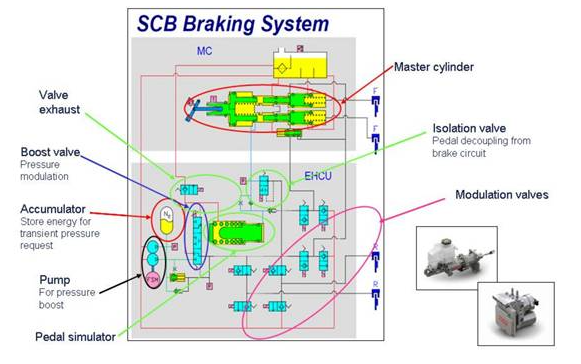
The EHB system is too complicated, the high-voltage accumulator is afraid of vibration, the reliability is not high, the volume is also large, the cost is also high, the service life is also questioned, and the maintenance cost is huge. In 2010, Hitachi launched the world's first dry EHB, namely E-ACT, which is also the most advanced EHB at present. ills. The R&D cycle of E-ACT is as long as 7 years, after nearly 5 years of reliability testing. It was not until 2013 that Bosch launched the first-generation iBooster, and the second-generation iBooster in 2016. The second-generation iBooster reached the quality of Hitachi's E-ACT, and the Japanese were ahead of the German generation in the field of EHB.
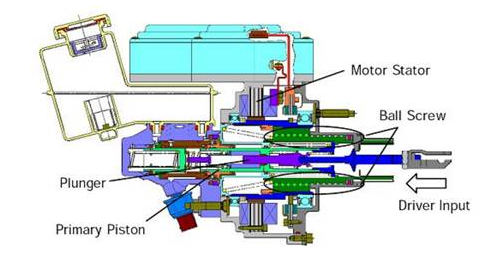
The above picture shows the structure of E-ACT
The dry EHB directly drives the push rod by the motor and then pushes the piston of the master cylinder. The rotational force of the motor is converted into a linear motion force through the roller screw (E-ACT). At the same time, the ball screw is also a reducer, which reduces the speed of the motor to Increased torque pushes the master cylinder piston. The principle is very simple. The reason why the previous people did not use this method is because the automobile braking system has extremely high reliability requirements, and sufficient performance redundancy must be reserved. The difficulty lies in the motor, which requires a small size of the motor, a high speed (over 10,000 revolutions per minute), a large torque, and good heat dissipation. The reducer is also difficult and requires high machining accuracy. At the same time, it is necessary to do system optimization with the master cylinder hydraulic system. Therefore, dry EHB appeared relatively late.
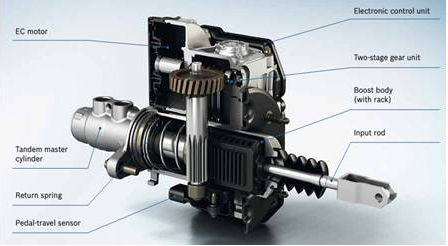
The picture above shows the internal structure of the first-generation iBooster.
The worm gear is used for two-stage deceleration to increase the linear motion torque. Tesla uses the first-generation iBooster across the board, as well as all of Volkswagen's new energy vehicles and Porsche 918 use the first-generation iBooster, GM's Cadillac CT6 and Chevrolet's Bolt EV also use the first-generation iBooster. This design is said to convert 95% of the regenerative braking energy into electricity, greatly improving the cruising range of new energy vehicles. The response time is also 75% shorter than the wet EHB system with high pressure accumulator.
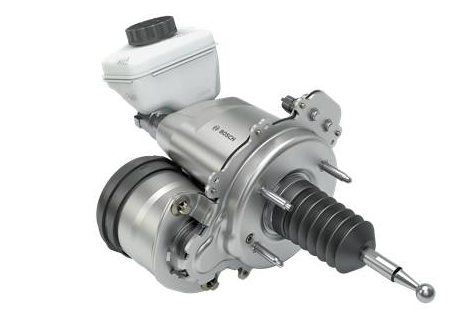
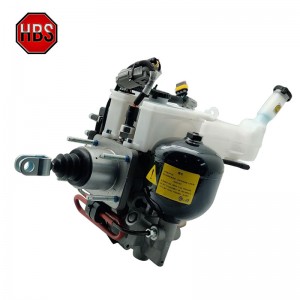
The right picture above is our Part# EHB-HBS001 Electric Hydraulic Brake Booster which is the same as the left picture above. The left assembly is the second-generation iBooster, which uses a second-stage worm gear to a first-stage ball screw for deceleration, greatly reducing the volume and improving the control accuracy. They have four series products and the booster size ranges from 4.5kN to 8kN, and 8kN can be used on a 9-seat small passenger car.
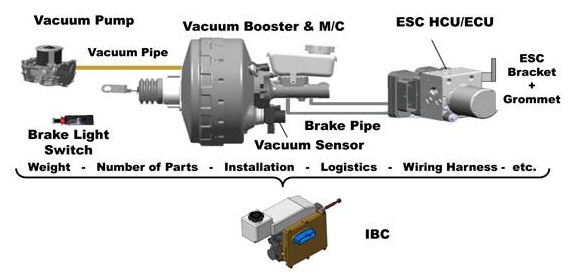
IBC will be launched on the GM K2XX platform in 2018, which is the GM pickup series. Note that this is a fuel vehicle. Of course, electric vehicles can also be used.
The design and control of the hydraulic system are complex, requiring long-term accumulation of experience and excellent machining capabilities, and there has always been a blank in this field in China. Over the years, the construction of its own industrial base has been neglected, and the principle of borrowing has been adopted completely; because the braking system has extremely high-reliability requirements, emerging companies cannot be recognized by OEMs at all. Therefore, the design and manufacture of the hydraulic part of the hydraulic brake system of the automobile are completely monopolized by joint ventures or foreign companies, and in order to design and produce the EHB system, it is necessary to do the docking and overall design with the hydraulic part, which leads to the entire EHB system. Complete monopoly of foreign companies.
In addition to EHB, there is an advanced braking system, EMB, which is almost perfect in theory. It abandons all hydraulic systems and has a low cost. The response time of the electronic system is only 90 milliseconds, which is much faster than iBooster. But there are many shortcomings. Disadvantage 1. There is no backup system, which requires extremely high reliability. In particular, the power system must be absolutely stable, followed by the fault tolerance of the bus communication system. The serial communication of each node in the system must have fault tolerance. At the same time, the system needs at least two CPUs to ensure reliability. Disadvantage 2. Insufficient braking force. The EMB system must be in the hub. The size of the hub determines the size of the motor, which in turn determines that the motor power cannot be too large, while ordinary cars require 1-2KW of braking power, which is currently impossible for small-sized motors. To reach the heights, the input voltage must be greatly increased, and even then it is very difficult. Disadvantage 3. The working environment temperature is high, the temperature near the brake pads is as high as hundreds of degrees, and the size of the motor determines that only a permanent magnet motor can be used, and the permanent magnet will demagnetize at high temperatures. At the same time, some semiconductor components of EMB need to work near the brake pads. No semiconductor components can withstand such a high temperature, and the volume limitation makes it impossible to add a cooling system. Disadvantage 4. It is necessary to develop a corresponding system for the chassis, and it is difficult to modularize the design, resulting in extremely high development costs.
The problem of the insufficient braking force of EMB may not be solved, because the stronger the magnetism of the permanent magnet, the lower the Curie temperature point, and the EMB cannot break through the physical limit. However, if the requirements for braking force are reduced, EMB can still be practical. The current electronic parking system EPB is EMB braking. Then there is the EMB installed on the rear wheel that does not require high braking force, such as the Audi R8 E-TRON.

The front wheel of the Audi R8 E-TRON is still a traditional hydraulic design, and the rear wheel is an EMB.
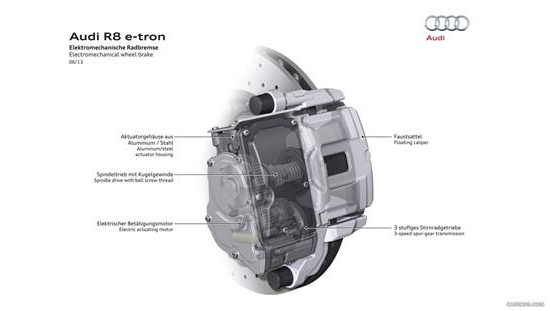
The picture above shows the EMB system of the R8 E-TRON.
We can see that the diameter of the motor may be about the size of the little finger. All brake system manufacturers such as NTN, Shuguang Industry, Brembo, NSK, Wanxiang, Wanan, Haldex, and Wabco are working hard on EMB. Of course, Bosch, Continental and ZF TRW will not be idle either. But EMB may never be able to replace hydraulic braking system.
Post time: May-16-2022

